
Tambourine and Cross
en
The Selkups:
save as...
About
the Project
CONTEXT
TRADITIONS
TROUBLES
The story of paganism
and Christianity mixed in one culture
ost modern Selkups are Orthodox, but they remember that in their childhood their grandmother would carve qawa losi (domestic idols) and that behind the village, there were three birch trees to which colorful ribbons were tied. Nowadays, people tie ribbons for fun, and shamans are perceived as scenic characters at The Northern Etudes festival.
text:
Valeria Bortnik
photo:
Natalia Bochkova, Alena Kardash
M
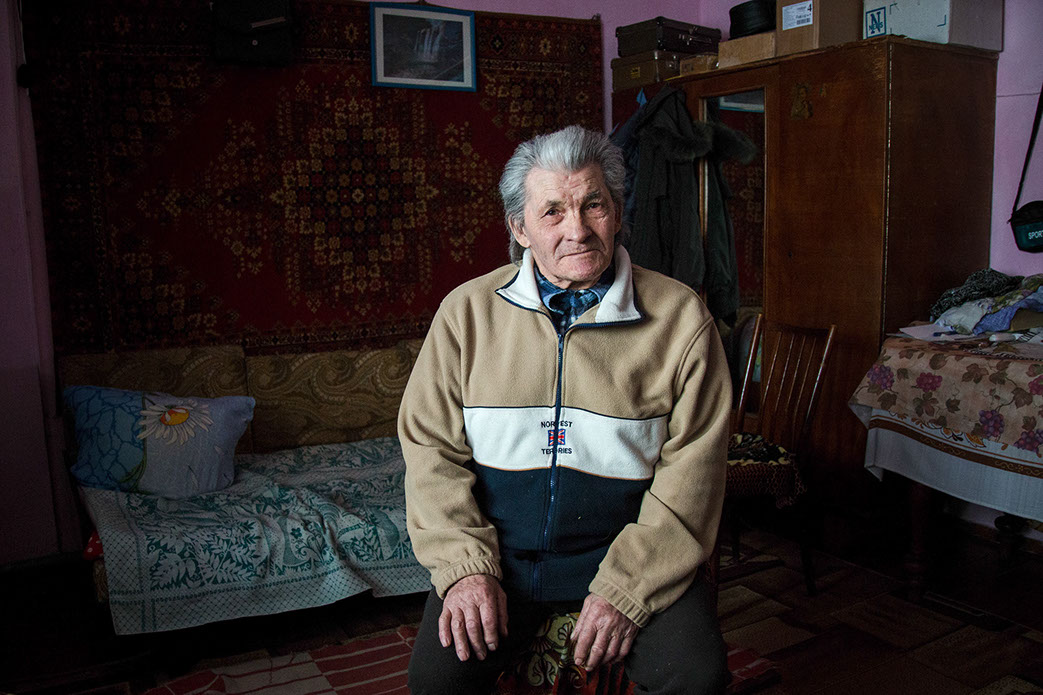
Before going to the forest, Ilarion Ivanovich still talk with lesovichok and gives a candy to kikimora, both creatures from Slavic mythology.

An icon at the bedside of Ilarion Ivanovich’s wife, an Orthodox Christian German woman.
A wide window-sill in Ilarion Izhenbin's room is completely laden with medicines. Ilarion Ivanovich is 76 years old, he is short, with gray hair looking like a cap.
“I am a pure-bred Selkup, not mixed”, Izhenbin says. Since childhood, he has been hunting, fishing, and going berry-picking to the forest. He stopped hunting a long time ago, but he still picks berries. And he takes along some food to thank forest creatures.
— Let's say I need to pick berries so I repeat three times: “Brothers, sisters, woodmen, woodwomen, help me pick enough berries”. If I go for cranberries, I take sweets or cookies and hang them on a knot because it's necessary to please the kikimora (a legendary creature, a female house spirit in Slavic mythology — translator's note) so that she leads me to berries. When I go to the forest, neither a squirrel nor a chipmunk is afraid of me. Another time I come and see them fighting. I think, “What a row-de-dow!” but then I look and see a cone on a stump; that’s why they're fighting! I say, “Stop”, and take a cone saying “I'm the biggest here so the cone is for me, and you'll run up to the cedar”.
Ilarion Ivanovich lights up when it comes to the forest. Speaking about the rustle of the leaves and the music of water, he chooses each word carefully.
— When I go into the woods, I greet the forest and do the same with the river, the stream, and the lake. All this is alive. Water can tell everything; you can take a look at the water and realize if all is well. If it is clean with no wrinkle, everything is fine; if it is cloudy and ripples, then there is a mess somewhere, and the water is nervous. Water plays music; another time wind can be playing. You know, no orchestra can create such kind of music. Or [there's music] in the spring when the forest comes into leaf; though now there is no such thing, the ecology is bad. And back then you would come and get the feeling that you got into the theater. Maybe, you've listened to the music of Tales from the Vienna Woods? It sounds as if the composer went to the woods and copied the music: the rustle of the leaf, the birds, and everything other as it's in real life.
During the conversation with Ilarion Ivanovich, it turns out that the Selkup superstitions have inseparably mixed with the Christian traditions. Izhenbin remembers Selkup-style Easter and Annunciation, which his baptized parents and his wife, an Orthodox German, celebrated.
— At Easter, as soon as it dawns, you need to fire a gun, which means that a hunt will be successful. My aunty Natashka has been hunting all her life; she is of the Christian faith, but when she goes hunting, she carves and places a wooden 'idol'. When she returns after a lucky hunt, she keeps the idol and sews panties and a shirt for it. If a hunt went bad, she doesn't sew anything for it, but immediately grabs it by the neck and throws it into the stove. She holds about a hundred of idols in a pantry, — Ilarion Izhenbin says, — You see: the faith is Christian, but the pagan rites still remain.
Cavalozy are talismans
in Samoyed mythology.
They personified several categories of spirits: evil spirits, spirits of disease,
host spirits, and the spirit-assistants to a shaman.
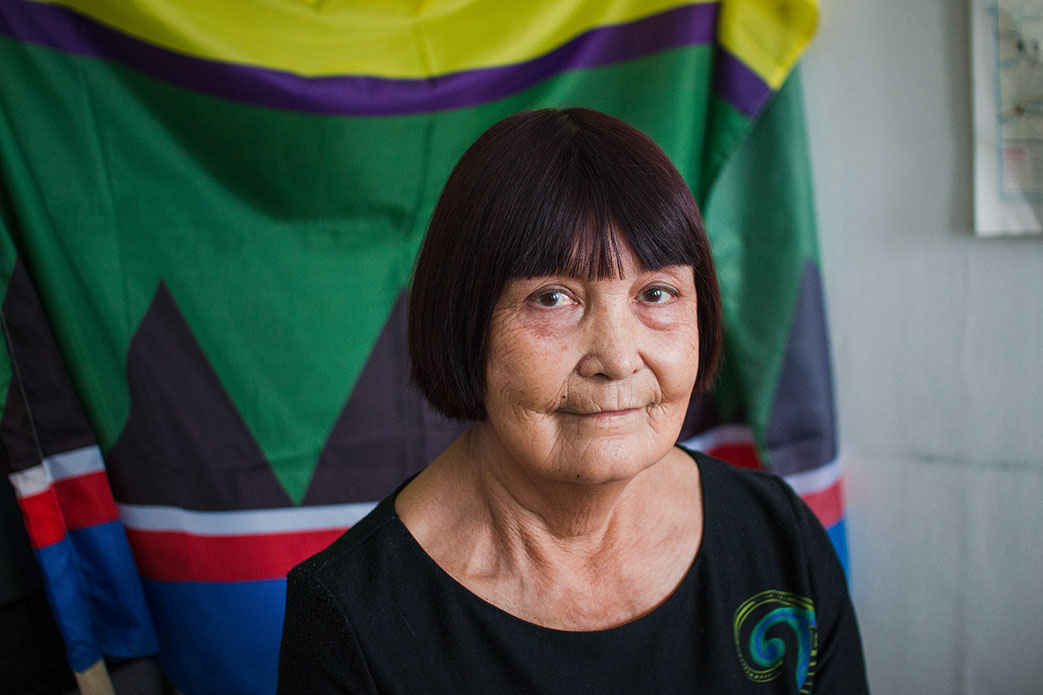
Lyudmila Denisovna combines forest superstitions and Orthodox beliefs.
We met with Lyudmila Shadrina after the rehearsal of the folk dancing and singing group Varg Kara in one of the offices of the culture department of Parabelsky district. Lyudmila Denisovna is 65, and she is a former primary school teacher. Her father is Selkup and her mother is Russian. She enthusiastically talks about the faith in her family. Lyudmila Denisovna is baptized, goes to church, though doesn’t do it often. However, her daughter and granddaughter worship regularly. The daughter embroiders icons with beads and gives them to all relatives.
— The Selkups had beliefs in their blood, — Lyudmila Denisovna says, — because when they went hunting, they used to ask the mother of taiga. When I go berry-picking in the forest, I ask for everything to be fine in my heart. We always say: “The beast has its own way, the man has his own”.
How do the forest superstitions go together with Orthodoxy? Why do they perform rituals and tell legends at The Northern Etudes festival? — I ask.
— I think, well, if you tied a ribbon, don't tell anyone, keep it to yourself, — Lyudmila replies, — My daughter combines useful and pleasant: she both goes to the church and can tie a ribbon at the festival. It's a tribute to the past. Everyone, even if they don't go to church, still addresses to someone and believes in someone in their heart. Let's say I fell ill and I pray to Panteleimon the Healer to reach out to our spiritual doctor, the God. I believe. And this suggestion helps, — Lyudmila says.
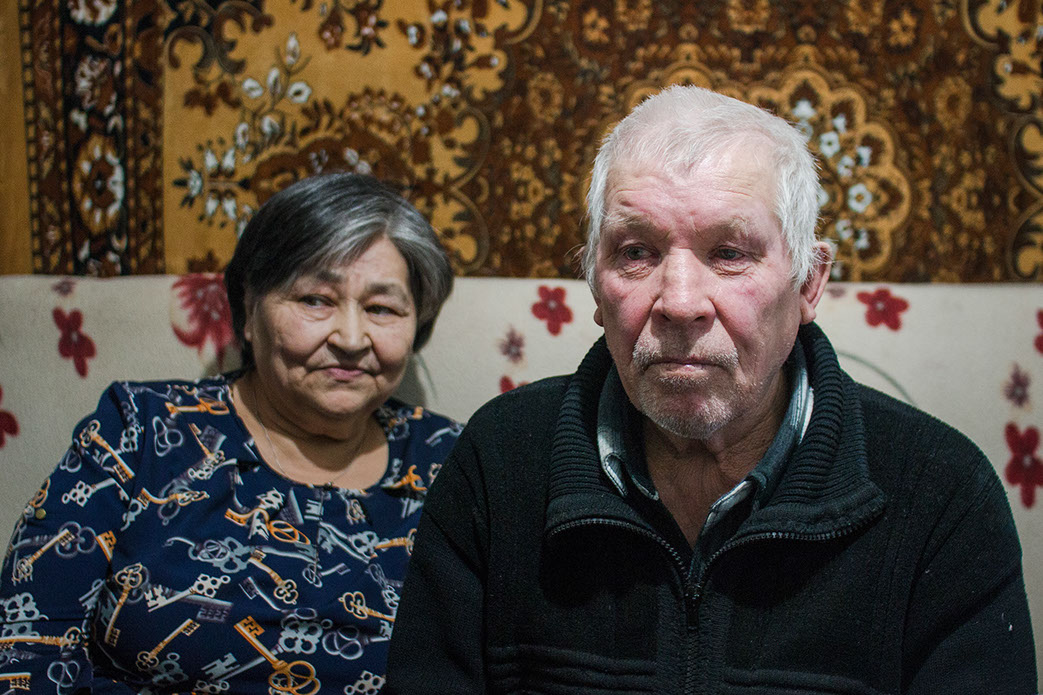
Vladimir Efimovich loudly argues about religion with his elder sister Svetlana Efimovna.
Vladimir Efimovich lives on a river bank; a long staircase leads down to
the house. It's turned out that we are not the only guests in the house of
the Izhenbins. Following us on the stairs, Vladimir Efimovich's sisters
came down.
The owner continues stoking the fire, while we begin our conversation in the kitchen with a round table and a small window overlooking the snow-covered river.
His younger sister, Svetlana Efimovna, lives in Tomsk and worships at the Alekseevskiy Monastery of the Blessed Virgin Mary. Svetlana remembers that in their childhood, there were no churches nearby, and children were simply immersed into the water, which was considered equivalent with baptism. “Our parents were also baptized; our great-grandfathers used to go to church; all of us are Orthodox. Now they show some shamans at the Etudes, but in real life, there were no shamans”.
Vladimir Efimovich joins us later and spins the yarns without waiting
for questions.
— Ninka’s Vovka used to play tambourine very well, so I said: “Vovka, you'd better go to Moscow, fool these Moscovites, tie those shamanic ribbons; it would be great”. He went there and told later: “Oooh, you must have seen how I made them dance around the birch trees”.
— But it's a sin to tie ribbons. If they tie, they do not go to church, but we go — can we even do this? — Svetlana is indignant.
— But it is just a symbolic ceremony, — Nina Efimovna joins in the conversation.
— What ceremonies are you talking about? This all is from Satan. I told you: “Do not go and do not tie any ribbons”, — Svetlana Efimovna instructs strictly.
— But I used to tie, — her sister responds.
— Now confess to the Holy Father (an informal way to call an Orthodox priest — TN) that you've tied, — Svetlana Efimovna responds indignantly.
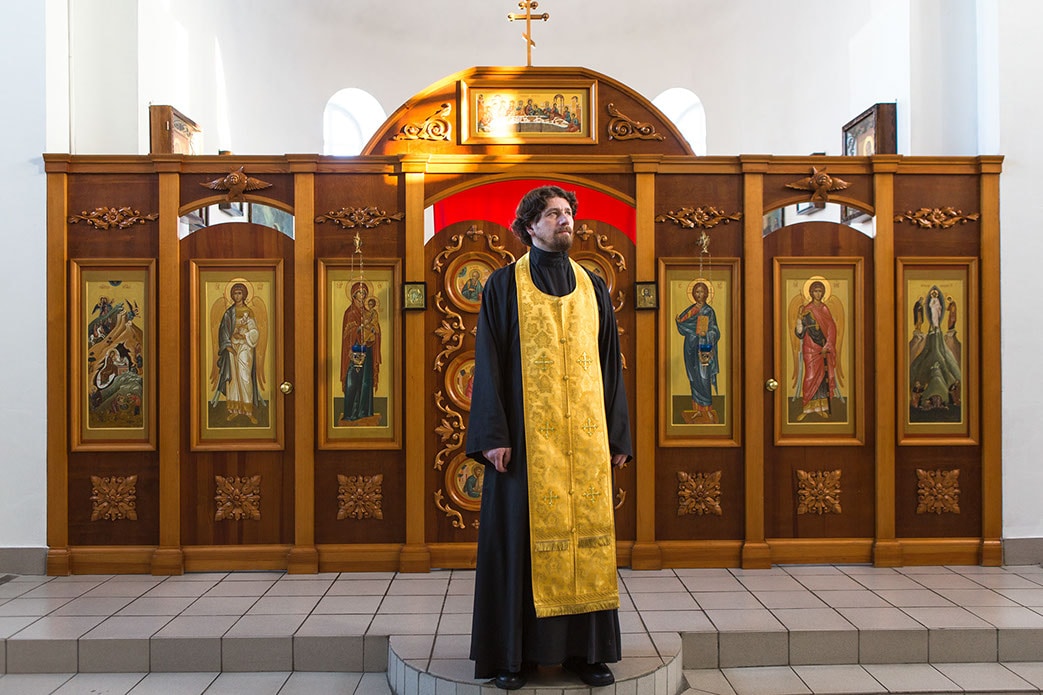
Father Alexander couldn’t relax at Lake Oskino. Alexander Freidman, a bishop in the parish of the Church of the Transfiguration of the Lord in Parabel village.
The festival of indigenous peoples of Siberia, The Northern Etudes, has been taking place for 12 years. Scenes and rites from the Selkup mythology are performed onstage every year. But this year there was a controversial situation. Previously, shamans were only scenic characters and the rituals were fictional, but in the summer of 2017, a practicing shaman was invited to Lake Oskino, where the festival is held annually. Many people did not like this mixture of culture and religion.
The Archpriest of Parabel' village church, father Alexander Freidman, does not single out the Selkups from the total number of worshipers; they also go to confession and children go to Sunday school. But after The Northern Etudes, Father Alexander stopped going to Lake Oskino.
— I have nothing against the national culture. But there is no use in connecting it with the pre-Christian pagan tradition artificially. The Selkups have been enlightened by the Christian faith for more than 150 years; so, what's the point in this? It is correct to revive the culture of the small-numbered peoples, but there is no need for a pagan religion, which already has a folkloristic character. Of course, the organizers of the festival needed to add something extra to spice things up. The main thing is that people do not attach much importance to this. They watched the shaman out of sheer curiosity.
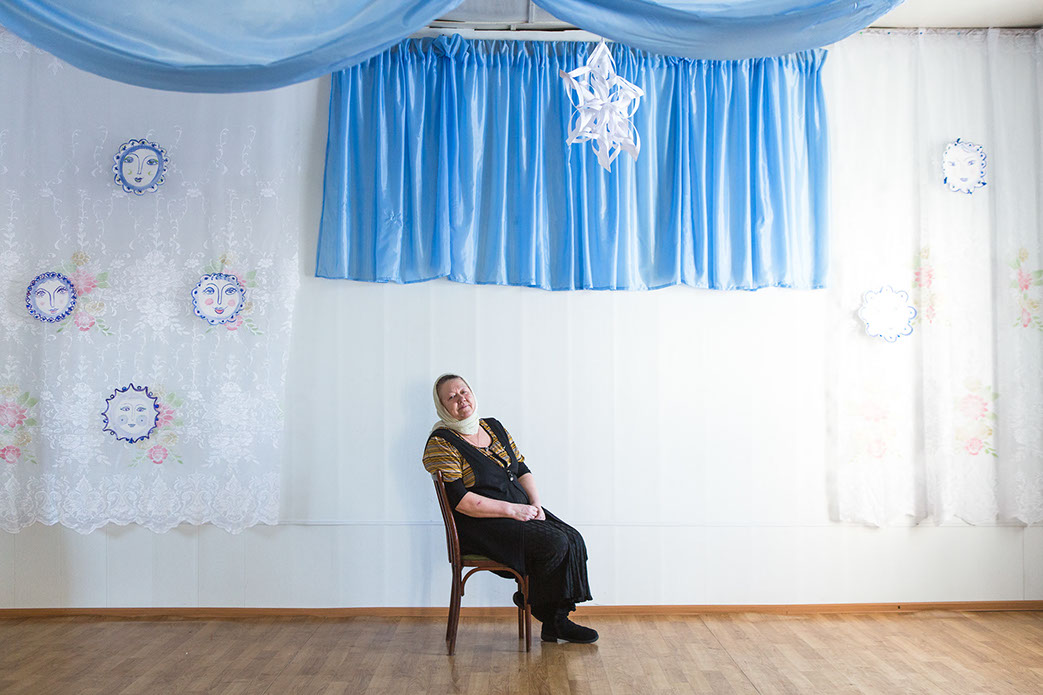
Zoya Baryshnikova talks about dancing with shamans at Sunday school during her youth.
In the same church of Parabel', we meet Zoya Baryshnikova. She is a parishioner of the church working with children and young people in Sunday school. While talking with us, Zoya Mikhailovna constantly adjusts a beige head cloth with a mottled pattern, asks many questions, and hastily talks about her youth, as if she is afraid of having not enough time to say everything. Zoya Efimovna herself is not Selkup, but in her youth, she was closely related to this culture.
— We make lots of mistakes, and here I, as a believer, have made a personal error. I'm a choreographer; once I made a dance performance with a shaman. I was interested so I read about shamans and their behavior. I had five men on the team; one played the role of a shaman. We covered tambourines with cloth, painted them. As for the choreography, the God has apparently given me some power of imagination. There's nothing complicated: just jump and skip. We also found a shaman costume in books. After all, nobody remembers shamans now. So, that’s how we did the performance. The fact that we showed shaman dances back then is my mistake; I understand this now. I wouldn't do this today. As if there are no other themes that are more sublime and noble.
Religious beliefs of the Selkups take their origin back to animism and shamanism, and end with mass baptism in the early 18th century. However, with the advent of the Orthodox culture, the traditional beliefs did not disappear. The last Selkup shaman of the southern area lived in Tym and died in the 1930s. We can still witness a lot of beliefs and rituals. But they are rather memories of the manifestation and merging of the pagan beliefs with the Christian culture.